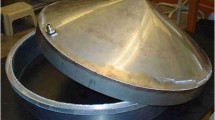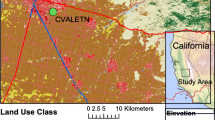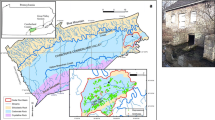Abstract
Frequent measurement of below ground water levels at multiple locations is an important component of many wetland ecosystem studies. These measurements, however, are usually time consuming, labor intensive, and expensive. This paper describes a water-level sensor that is inexpensive and easy to construct. The sensor is placed below the expected low water level in a shallow well and, when connected to a datalogger, uses a pressure transducer to detect groundwater or surface water elevations. Details of pressure transducer theory, sensor construction, calibration, and examples of field installations are presented. Although the transducers must be individually calibrated, the sensors have a linear response to changing water levels (r 2 ≈ .999). Measurement errors resulting from temperature fluctuations are shown to be about 4 cm over a 35°C temperature range, but are minimal when the sensors are installed in groundwater wells where temperatures are less variable. Greater accuracy may be obtained by incorporating water temperature data into the initial calibration (0.14 cm error over a 35C temperature range). Examples of the utility of these sensors in studies of groundwater/surface water interactions and the effects of water level fluctuations on tree growth are provided.
Similar content being viewed by others
References
Conner, W.H., Gosselink, J.G., and Parrondo, R.T. 1981. Comparison of the vegetation of three Louisiana swamp sites with different flooding regimes. Am. J. Bot. 68: 320–331.
Day, F.P., West, S.K., and Tupacz, E.G. 1988. The influence of ground water dynamics in a periodically flooded ecosystem, the Great Dismal Swamp. Wetlands 8: 1–13.
Dedrick, A.R. and Clemmens, A.J. 1984. Double bubblers coupled with pressure transducers for water level sensing. Trans. American Soc. Agric. Engr. 27: 779–783.
Dowd, J.F. and Williams, A.G. 1989. Calibration and use of pressure transducers in soil hydrology. Hydrological Processes 3: 43–49.
Dunne, T. and Leopold, L.B. 1978. Water in environmental planning. W.H. Freeman and Company, New York.
Freeze, R.A. and Cherry, J.A. 1979. Groundwater. Prentice-Hall, Inc., Englewood Cliffs, New Jersey.
Gelhar, L.W. and Axness, C.L. 1983. Three-dimensional stochastic analysis of macro-dispersion in aquifers. Wat. Resources Res. 19: 161–180.
Hardegree, W.S. 1990. Separating stream flow from Savannah River backwater and groundwater by means of oxygen-18. M.S. Thesis, University of Georgia, Athens, GA, 93 pp.
Jennings, M.E. and O'Neil, C.P. 1976. Simulation of forest changes related to hydrologic variables in the Atchafalaya River basin, Louisiana. J. Res. U.S. Geological Survey 4: 481–489.
Keeland, B.D. and Sharitz, R.R. 1995. Seasonal growth patterns of Nyssa sylvatica var. biflora, N. aquatica, and Taxodium distichum as affected by hydrologic regime. Can. J. For. Res. 25: 1084–1096.
Keeland, B.D. and Sharitz, R.R. 1997. The effects of water-level fluctuations on weekly tree growth in a Southeastern USA swamp. Am. J. Bot. 84: 131–139.
Keeley, J.E. 1979. Population differentiation along a flood frequency gradient: Physiological adaptations to flooding in Nyssa sylvatica. Ecol. Monogr. 49: 89–108.
Kozlowski, T.T. 1984. Plant responses to flooding of soil. BioScience 34: 162–167.
Mitsch, W.J. and Gosselink, J.G. 1993. Wetlands, 2nd edn. Van Nostrand Reinhold, New York, 537 pp.
SAS Institute Inc. 1988. SAS/STAT Users Guide, Release 6.03 Edition. SAS Institute Inc., Cary, NC, 1028 pp.
Schwartz, F.W. 1977. Macroscopic dispersion in porous media: the controlling factors. Wat. Resources Res. 13: 743–752.
Siegel, D.I. 1988. A review of the recharge-discharge function of wetlands. In: Hook, D.D. et al. (eds), The Ecology and Management of Wetlands. Vol I: Ecology of Wetlands. pp. 59–67. Timber Press, Portland, OR.
Sophocleous, M.A. 1991. Combining the soilwater balance and water-level fluctuation methods to estimate natural groundwater recharge: practical aspects. J. Hydrology 124: 229–241.
Stricker, V.A. 1983. Base flow of streams in the outcrop area of the southeastern sand aquifer: South Carolina, Georgia, Alabama, and Mississippi. U.S. Geological Survey Water-Resources Investigations 83–4106.
Viessman, W., Jr., Knapp, J.W., Lewis, G.L., and Harbaugh, T.E. 1977. Introduction to hydrology. Harper &Row, Publishers, New York, 704 pp.
Winter, T.C. 1981. Uncertainties in estimating the water balance of lakes. Wat. Resources Bull. 17: 82–115.
Author information
Authors and Affiliations
Rights and permissions
About this article
Cite this article
Keeland, B., Dowd, J. & Hardegree, W. Use of inexpensive pressure transducers for measuring water levels in wells. Wetlands Ecology and Management 5, 121–129 (1997). https://doi.org/10.1023/A:1008203625917
Issue Date:
DOI: https://doi.org/10.1023/A:1008203625917




